|
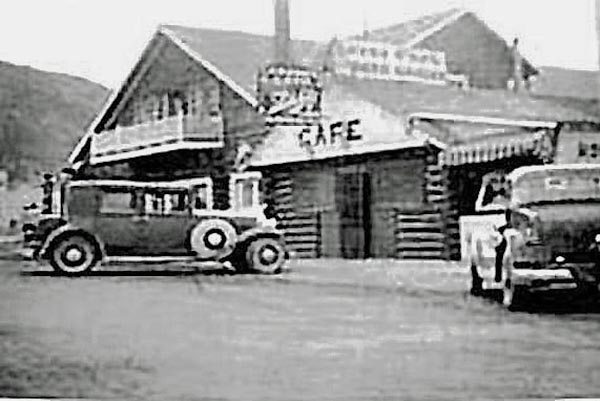
Joe Ruby's Cafe and Beer Garden, 1934.
Cache Street on the west side of the Town Square is one of the few streets in Jackson which remains recognizable from prior
to World War II, primarily because of four structures, the Million Dollar Cowboy Bar at 25 N. Cache Street,
St. John's Episcopal Church, the former Jackson Drugs on the corner of Deloney and Cache, and the Teton Theater. The Cowboy Bar traces its
history back to Joe Ruby's Cafe and Beer Garden established about 1934 by Joe Ruby (1885-1958). The bar was established
on the original site of the Jackson State Bank founded by R. E. Miller. The bank opened in 1914 and in 1926 moved from
N. Cache to a building owned by
Henry Crabtree adjacent to the Crabtree Hotel on E. Broadway. Ruby moved to Jackson from Rock Springs where he ran a
confectionery and soda fountain on Pilot Butte Avenue. Ruby was born in the old Austro-Hungarian Empire and came to the
The United States in 1903. He and his wife Anna (1895-1985) moved to Green River from Salt Lake City about 1917. In 1936, the beer garden was sold
to Ben Goe, Sr., a local rancher and reputed moonshiner. Goe renamed the establishment the "Cowboy Bar" and fixed it up a bit.
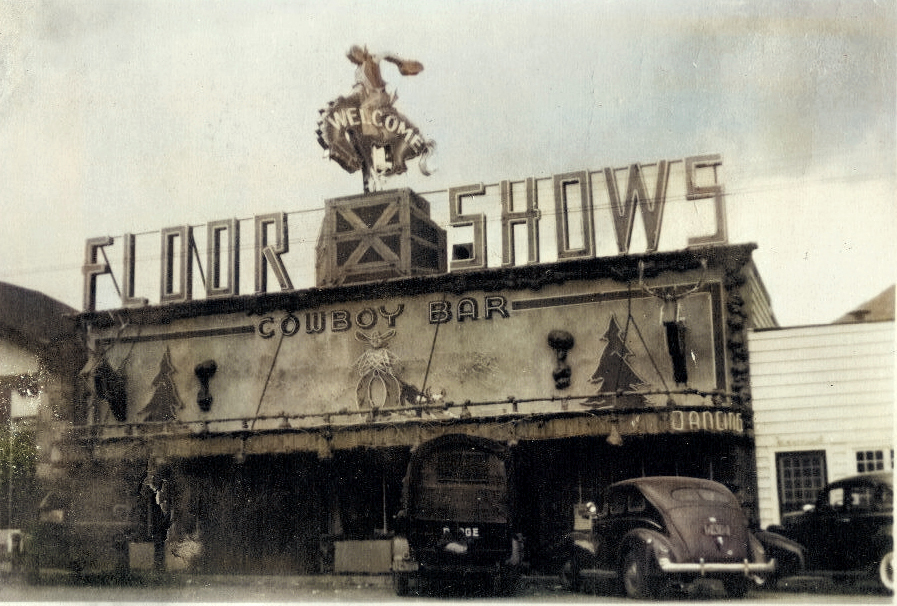
Ben Goe's Cowboy Bar, 1938.
Following the sale of
the bar to Goe, the Rubys moved back to Salt Lake City. Both died and are interred there in the Murray Cemetery.
In 1910, a writer for Outing Magazine Dillon Wallace (1863-1939) ventured into Jackson coming up through Hoback Canyon with his pack train into
Cheney. Cheney was a small town about six miles south of Jackson. Wallace was unimpressed with Cheney. At the time the town consisted of little more than Selar Cheney's ranch and the post office of which
Cheney was postmaster. Cheney (1859-1922) was one of the first Mormon settlers within Jackson's Hole. The Post Office, opened in 1902 replacing the one at South Park. It closed in 1917.
Dillon Wallace was a lawyer who made his fame as an explorer and writer when he participated in an expedition into the wilds of
Labrador was led by an assistant editor of Outing Magazine Leonidas Hubbard, Jr. On the expedition into the dank and cold, the intrepid explorers failed to
catch enough game or fish. The party was left to survive on rawhide and bone water seasoned with yeast. Hubbard died of starvation whilst Wallace read to him John 14.
The adventures of the party and the death of Hubbard were published as a serial in the Outing Magazine and a book, "The Lure of the Labrador Wild."
Hubbard's widow was less than pleased
with the book. When Wallace determined to venture once again into Labrador, Mrs. Hubbard mounted her own expedition which followed her husband's original route.
Mrs. Hubbard's expedition proved to be the more rapid beating Wallace by a matter of weeks thereby vindicating her late husband. Each wrote of their respective
expeditions, neither mentioning the other.
Jackson at the time certainly met the counsel of Rudyard Kipling quoted by Wallace in the preface to his
Labrador book: "Something hidden. Go and find it. Go and Look behind the Ranges--Something lost behind the Ranges. Lost and Waiting for you. Go!"
The Jackson Hotel was described by
Wallace"
It was a Sunday near dinner time when I reached Jackson and registered at the little hotel.
Saddled horses stood along the streets and the hotel office was crowded with ranchers and
cowboys who had ridden in to spend the day, using the office as a general gathering place and
clubroom. After a very good dinner, at which elk meat was served, I joined the assemblage in
the office, and spent the afternoon and evening smoking, listening, and assimilating such
information as I could relative to the attitude of the people toward the game situation, and
the game situation here centers upon elk.
A group of young men were holding a lively argument when I entered the hotel office as to
each other's relative attainments as a "bronco buster." At a recent gathering all of them
had been unseated by a bull owned by the hotel keeper, save one man, who had not yet attempted
to master the animal. He swaggered around in hairy chaps, high-heeled boots, and with a big
revolver on his belt. He asked them to bring the bull out and he would show the defeated ones
how to ride it. For a time it seemed as though we were to have an exhibition of wild bull
riding, but the landlord killed our hopes with the statement that the bull was out on the range
and it would require several hours to bring him in.
I asked a quiet man next me who the boastful one was.
"Oh, he's a feller works around. He's diggin' a well for a ranchman up here now."
"Why," said I, "I thought from his outfit he was a cowpuncher."
"What, him!" exclaimed my informant. "He'd stampede a bunch o' steers with his yawp. He can
bust broncs though. He is some rider."
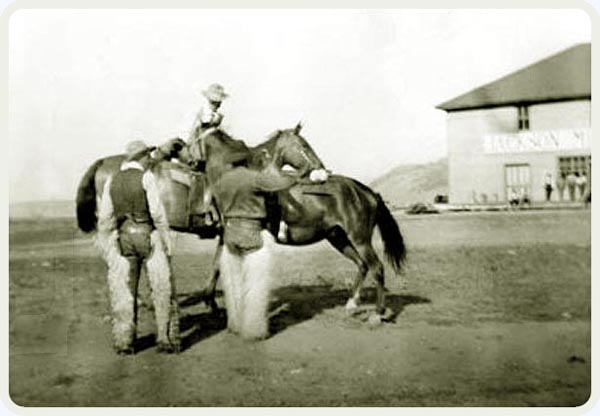
Cowboys wearing "hairy chaps" in front of the
Clubhouse, approx. 1910.
In the early 1900's, Angora chaps, "woolies," were de rigueur in Wyoming and Montana. In contrast to
batwing or shotgun chaps the woolies had the
advantage of being warmer and shedding water.
Besides the Hotel Jackson there were other gathering places. One was
Reuben Monroe "Rube" Tuttle and Theophilus W. Lloyd's saloon.
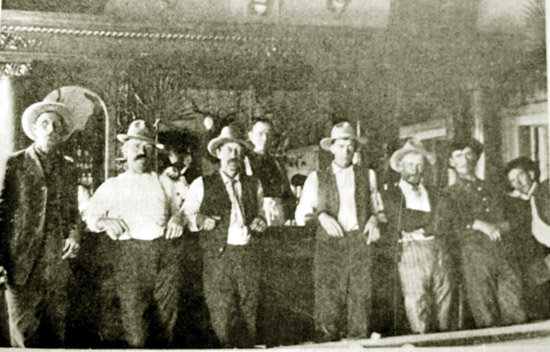
Scene in Tuttle and Lloyd's Saloon, undated.
Left to Right: Wagon coal miner named Johnson, Josiah "Si" Ferrin; Charlie Harvey; Bartender Frank Peterson; Link Jameson; Unidentified; William L.
"Billy" Stilson; unidentified.
There is disagreement as to identification of persons in photo. They have also been identified as:
S. L. Spicer; Bar Proprietor Reuben M. Tutttle; Willard Miner, Sr.; Bartender Theophilus W. Lloyd;
Walt Spicer; Frank LaShaw; Jack Gray, and Alva Simpson.
Rube Tuttle (1870-1950) came "over the hill" into Jackson about 1902 and started the saloon. His was the first brick building in
Jackson. Before then he had been a solicitor and collector for the Fish Brewing Co.of Salt Lake City.
Prior to working for Fish, he was a range rider in
southern Utah. By 1911, he had returned to Utah with Theophilus Lloyd owning the bar. Tuttle died in Venice, California.
In 1916, Lloyd (1873-1937) sold the saloon to M. E. Meeks of Marbleton, Wyoming. Lloyd along with Jack Enyon, Cunningham Pierce and Roy Van Vleck
are regarded as the organizers of Jackson's Frontier Days Rodeo. Lloyd sometime in the 1920s joined a gold rush to the Kachemak Bay
region of Alaska where he operated the Teton Fox Farm raising blue foxes. The name of the saloon was briefly revived in 1990.
In Jackson, Wallace was introduced to S. N. Leek by the
Reverend Robert Magee Beckett. In the Tetons, Wallace used Leek as a guide. Leek was already well known
for his interest in photography and the preservation of Elk discussed with regard to the Grand Tetons. At the time,
Elk had been almost driven to the point of extinction. The only remaining location where they were commonly found was Jackson Hole where on
occasion they would make a nuisance of themselves, taking up residence in stables and blocking streets. One tried to check into the
Crabtree Hotel using the back door.
The Reverend Beckett had graduated from the Philadelphia Divinity School on June 3, 1909, and was assigned as a missionary to Wyoming.
three days later, the Reverend Nathaniel Syemour Thomas, Rector of the Church of the Holy Apostles in Philadelphia was consecrated as Bishop of
Wyoming. Bishop Thomas was the first bishop in the Episcopal church to be designated exclusively to the state. Previous bishops also served parts of other western states.
Beckett was assigned to St. John in Jackson and St. Andrew in Grosvont. A year later in Cheyenne, the Reverend Beckett was ordained by Bishop Thomas.
Even though the St. Matthews Cathedral was in
Laramie, Bishop Thomas made Cheyenne his seat. In July,
the Reverend Beckett and Bishop Thomas then set off on a six week, 1100 mile trek up through the Wind River Reservation, Hudson, Lander,
Riverton, Thermopolis, Meeteetse, Cody, up to Yellowstone and down through Jackson's Hole to Jackson stopping at isolated ranches, baptizing children,
and giving communion. The Bishop traveled by horseback and wagon camping in the open between towns.

Campsite of Wyoming Archdeacon Ernest Dray on pastoral visit to Jackson's Hole, 1913.
In Jackson's Hole, Bishop Thomas discovered that over the summer there had been seven
maternity cases in which three of the mothers had died. Standing at the death bed of one of the
dying mothers, the Bishop determined that he and the Church would do something about it. The result was the
construction of the Bishop Randall Hospital in Lander and the construction of a hostel in Jackson to the north of the Jackson Hotel. The hostel provided a five-bed hospital and
a Church House. Archdeacon Ernest Dray in a letter to the
Junior Auxiliary described a similar journey to Jackson and explained the purpose of the hostel:
In Jackson, the town in the "Hole," the Bishop is building a Church House, or "Hostel," where the ranchmen,
who come long distances into town, can find a place to rest and read, or take part in some harmless amusement.
Poor fellows, some of them are very weak and easily fall into bad habits; and the purpose of the Hostel is to give them some safe,
wholesome occupation, so that they may not seek anything harmful.
In Anglican parlance, an archdeacon is one who has been called to holy orders and ranks above a priest and immedately below a bishop. He is
usually assigned to administration of Church properties and is the "eyes and ears" of the bishop. Rather than being referred to as
"The Reverend" he is referred to as "The Venerable." The Venerable Archdeacon Dray (1859-1938) prior to being assigned to Wyoming was the
rector of St. Clement's in St. Paul, Minn. He was originally from England and ultimately retired there. He died in Howton, Bushey Heath, Hereford, in 1938. Bishop Thomas, although
originally from Rice County, Minn., was educated at Cambridge. In staffing Wyoming, the Bishop had to bring in many from the east.
In February 1913, the Rev. Seth C. Hawley originally from Bergen County, New Jersey was assigned to St. John's. He came in over the Pass.
A year later in 1914 he was assigned to St. Andrews in Manitou, Colorado. Following the Rev. Hawley in Jackson was the Reverend Royal H. Balcom (1880-1943) who served
at St. John's from approximately 1914 to 1916. He previously
served at St. Barnabas, Irvington on the Hudson, New York and
later served at St. Michael's at Ethete, Wyoming, from 1917 to 1925. The Reverend Balcom planned the construction of the Chapel of the Transfiguaration near Moose.
The bell at the chapel came from
St. Barnabas. The Reverend Balcom was followed by the Reverend M. B. Nash and then by the Reverend Harold Johns. Each were old-fashioned circuit riders conducting services not only in Jackson but
in Kelly and Flat Creek. A typical Sunday would include Church School in Jackson at 10:00 a.m., followed by the Service. A service might be given at Flat Creek at
2:00 p.m. and the day would end with Sunday School at Trinity in Kelly followed by a Service at 8:00 p.m.
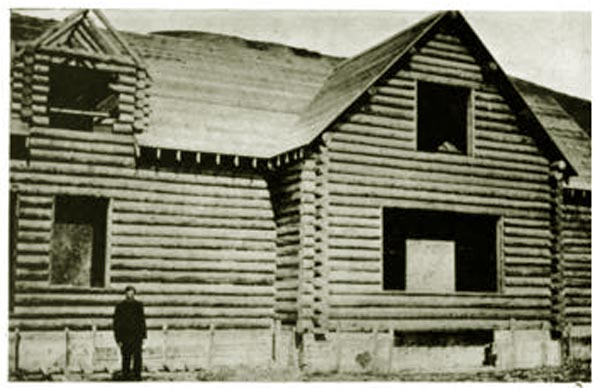
St. John Hostel under construction, 1911. Individual standing in front believed to be
the Reverend Beckett.
Construction of the building was a community effort. George R. Blain with his son Clarence cut and peeled the logs,
Blain was the town taxidermist and tanner, a guide and police justice. He was also an
officer in the Odd Fellows. Roof lumber was milled in Charles Fox's sawmill. Framing and construction was by
Milton J. "Butch" Robinson and his brother Edwin J. "Ed" Robinson who ranched along the
Grovont. Butch was experienced with log work. About 1904, he devised a method of constructed a round cowshed without the necessity of using a center support.
It made cleaning of the shed much easier. Billy Mercill provided some of the supplies for the church building.
The church was consecrated by
Bishop Thomas and the Reverend Balcom.
St. John's Medical Center, a regional 108-bed facility at 108 E.
Broadway, is an outgrowth of the original Hostel.
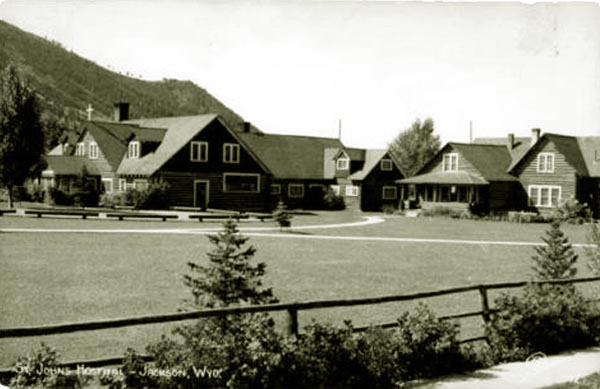
St. John's Hospital, Jackson, approx. 1940., Photo by Wm. P. Sanborn.
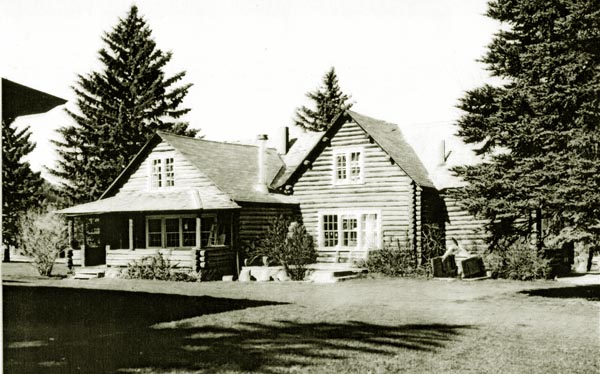
St. John, Hostel, 1970's.
Next Page: Jackson Continued, The Cowboy Bar.
|